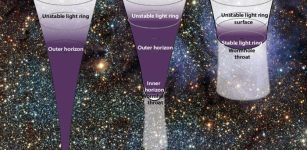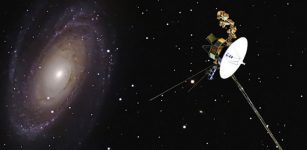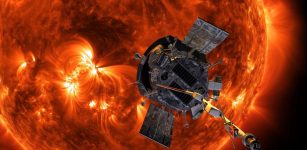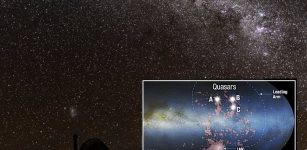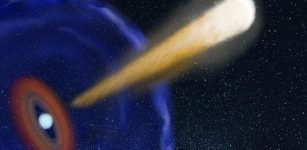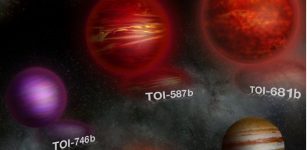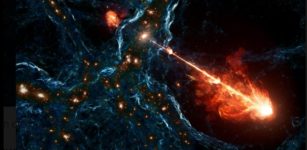ALMA Discovers Rotating Baby Galaxy Only 1/100th Size Of Milky Way
Eddie Gonzales Jr. – MessageToEagle.com – Using the Atacama Large Millimeter/submillimeter Array (ALMA), astronomers found a rotating baby galaxy 1/100th the size of the Milky Way at a time when the universe was only 7 percent of its present age.
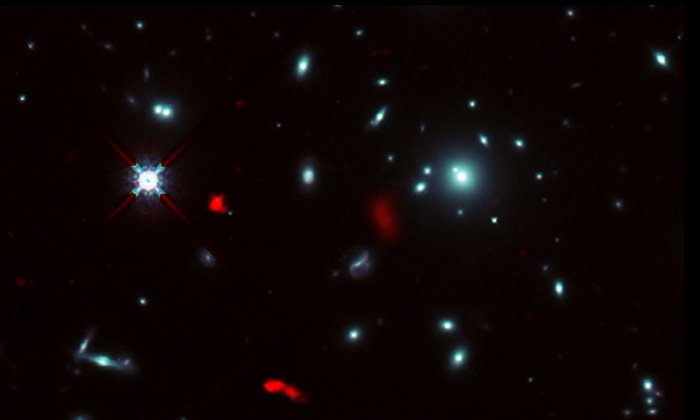 The galaxy cluster RXCJ0600-2007 taken by the NASA/ESA Hubble Space Telescope, combined with gravitational lensing images of the distant galaxy RXCJ0600-z6, 12.4 billion light-years away, observed by ALMA (shown in red). Due to the gravitational lensing effect by the galaxy cluster, the image of RXCJ0600-z6 was intensified and magnified, and appeared to be divided into three or more parts. Credit: ALMA (ESO/NAOJ/NRAO), Fujimoto et al., NASA/ESA Hubble Space Telescope
The galaxy cluster RXCJ0600-2007 taken by the NASA/ESA Hubble Space Telescope, combined with gravitational lensing images of the distant galaxy RXCJ0600-z6, 12.4 billion light-years away, observed by ALMA (shown in red). Due to the gravitational lensing effect by the galaxy cluster, the image of RXCJ0600-z6 was intensified and magnified, and appeared to be divided into three or more parts. Credit: ALMA (ESO/NAOJ/NRAO), Fujimoto et al., NASA/ESA Hubble Space Telescope
Thanks to assistance by the gravitational lens effect, the team was able to explore for the first time the nature of small and dark “normal galaxies” in the early universe, representative of the main population of the first galaxies, which greatly advances our understanding of the initial phase of galaxy evolution.
“Many of the galaxies that existed in the early universe were so small that their brightness is well below the limit of the current largest telescopes on Earth and in Space, making difficult to study their properties and internal structure,” says Nicolas Laporte, a Kavli Senior Fellow at the University of Cambridge, in a press release.
“However, the light coming from the galaxy named RXCJ0600-z6 was highly magnified by gravitational lensing, making it an ideal target for studying the properties and structure of a typical baby galaxy.”
Gravitational lensing is a natural phenomenon in which light emitted from a distant object is bent by the gravity of a massive body such as a galaxy or a galaxy cluster located in the foreground. When we look through a gravitational lens, the light of distant objects is intensified and their shapes are stretched. In other words, it is a “natural telescope” floating in space.
The team studied 33 galaxy clusters that could cause gravitational lensing. One of these clusters, called RXCJ0600-2007, is located in the direction of the constellation of Lepus and has a mass 1000 trillion times that of the Sun. The team also determined that the galaxy is seen as it was about 900 million years after the Big Bang (12.9 billion years ago). Further analysis of these data suggested that a part of this source is seen 160 times brighter than it is intrinsically.
The total mass of this galaxy is about 2 to 3 billion times that of the Sun, which is about 1/100th of the size of our own Milky Way Galaxy.
What astonished the team is that RXCJ0600-z6 is rotating. Traditionally, gas in the young galaxies was thought to have random, chaotic motion.
“Our study demonstrates, for the first time, that we can directly measure the internal motion of such faint (less massive) galaxies in the early Universe and compare it with the theoretical predictions”, says Kotaro Kohno, a professor at the University of Tokyo and the leader of the ALCS team.
“The fact that RXCJ0600-z6 has a very high magnification factor also raises expectations for future research,” explains Seiji Fujimoto, a DAWN fellow at the Niels Bohr Institute.
Written by Eddie Gonzales Jr. – MessageToEagle.com Staff

